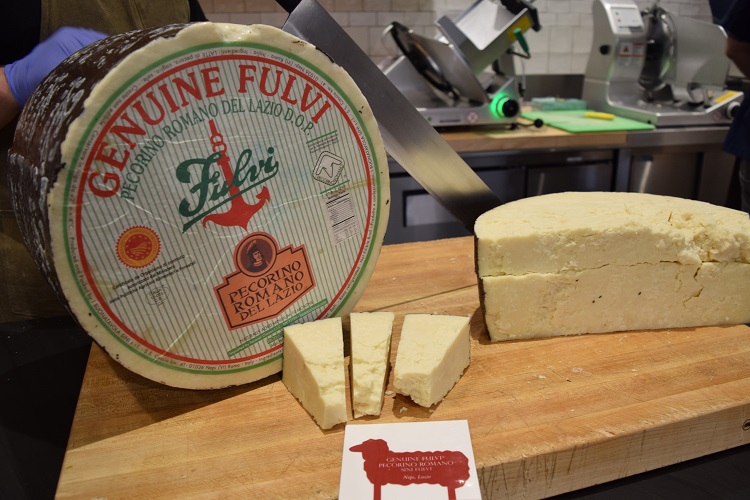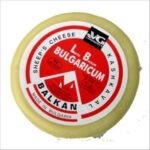Originating from the beautiful landscapes of Italy, Pecorino Romano Cheese is often acclaimed as one of the world’s oldest types of cheese, with its production dating back to almost 2000 years. The cheese marvels gourmets with its hard texture, aromatic scent, and its characteristically sharp, salty taste. But what makes this cheese truly remarkable is its traditional journey, taking us back to the days of the Roman Empire when it was served to the legionnaires as a fundamental part of their diet. It’s undoubtedly a cheese with a rich historic past that enriches its flavor and allure.
Produced entirely from the milk of sheep that graze freely on the lush, wild pastures of Sardinia, Lazio, and the province of Grosseto in Southern Tuscany, Pecorino Romano cheese is a testament to its terroir. It takes around 8 months to a year to fully mature this gourmet delight, developing a crumbly yet dense texture, and a color that ranges from white to pale straw.
- Flavor Profile: Composed of a strong, penetrating aroma, Pecorino Romano’s taste can be described as sharp, tangy, and full-flavored with a delightful saltiness. This profound and unique flavor characterizes it among other cheeses, making it an exceptional choice for grating over pasta dishes, stirring into risotto, or simply enjoying with a robust glass of Italian wine.
Inculcating traditional practices and components accredited with Protected Designation of Origin (PDO), it ensures the highest quality end product. Only natural, local rennet obtained from the lamb and goat kids, and sea salt are used in its production that attests to a truly Mediterranean heritage.
The impeccable amalgamation of the cheese’s historic legacy, nuanced flavor profile, as well as the traditional and painstakingly stringent method of its preparation collectively underscore the specialty of the Pecorino Romano cheese. So the next time you savor a piece of this stellar cheese, let it transport you to the sprawling landscapes of Italy where it was born and has been painstakingly crafted for centuries.
Welcome to our quiz on the topic of ‘Pecorino Romano’! Discover how well you know your way around one of the most iconic cheeses of Italy and its glorious gastronomic legacy. Are you ready to challenge your knowledge about this flavorful and historical cheese? Start now!

Recognizing and Appreciating the Quality of Pecorino Romano Cheese
Known for its sharp, salty flavor, Pecorino Romano stands as one of the oldest types of cheese with a history that traces back to ancient Roman times. Originating from Italy’s Lazio, Sardinia, and Grosseto regions, this hard, sheep’s milk cheese allures culinary enthusiasts with its distinctive characteristics and quality. Identifying and appreciating this cheese involves understanding its making process, appearance, aroma, and taste.
The production process of Pecorino Romano is strictly regulated according to the Protected Designation of Origin (PDO) conditions. This ensures the cheese’s consistency in high quality. Authentic Pecorino Romano is made exclusively from the whole, fresh milk of sheep raised in the designated regions. The milk is curdled using lamb’s rennet, and the curds are carefully cooked, molded, and salted. The wheel of cheese is then aged for a minimum of five months, going up to eight months to mature fully.
A keen eye will notice the cheese’s distinct appearance. It has a hard, pale yellow to white interior, while its rind is black or pale straw in color. The cheese has few or no small holes, and a quality wheel of Pecorino Romano weighs between 20 – 35kg with a diameter of 30 – 35cm. To spectate its quality even further, savor the aroma. Pecorino Romano emits a fresh and fruity scent with salty notes. High-quality variants deliver a flavor that is aromatic, tangy, and pleasantly sharp with a hint of a salty bite.
- This cheese pairs remarkably well with robust red wines like Chianti or Barolo. You can incorporate it into pasta, risotto, or other vegetable dishes, giving them an intense, savory taste.
By understanding the intricacies involved in its production, the captivating facets of its appearance, flavor, and aroma, anyone can unlock the pleasure of appreciating the quality of Pecorino Romano cheese. It is indeed a unique treasure in the world of cheese.
Delving Into the Intricacies of Pecorino Romano Cheese
The Italian staple Pecorino Romano is a superior and rich cheese variety that’s widely venerated for its unique properties and phenomenal taste profile. Produced in specific regions of Italy like Sardinia, Grosseto, and Lazio, this cheese delicacy is made only from fresh, pure sheep’s milk inherently rich in vitamins A & B, calcium, and phosphorus. Furthermore, Pecorino Romano’s aging process usually ranges from five months to a year, and during this period, it acquires its distinctive savoury and sharp flavour, which is both intense and salty.
Delve deeper into the properties of Pecorino Romano, and one could differentiate it based on the treatment the cheese undergoes after the ageing process. There are typically three categories namely Stagionato (aged more than 8 months), Semistagionato (aged between 5 to 8 months), and Fresco (aged less than 5 months). Each exhibits unique characteristics – Fresco, for example, is creamy and mellow, whereas Semistagionato has a more assertive flavor. Stagionato, on the other hand, is hard and piquant, with a slightly grainy texture. It’s the longer-matured variant and often served as grating cheese over pasta dishes, bread and soups.

Each wheel of Pecorino Romano comes embossed with the mark of the Consortium for the Protection of Pecorino Romano (Consorzio per la Tutela del Pecorino Romano) – a recognized seal of guarantee that stands for quality, authenticity and adherence to traditional methods of cheese-making. The distinctive features of Pecorino Romano also include its bright straw-yellow hue and a cylindrical shape with slightly convex sides.
Nutrition-wise, Pecorino Romano stands tall with its wealth of nutrients. A 100-gram serving provides around 370-400 kilocalories, 26 grams of protein, high levels of calcium (over 1000mg) and a significant proportion of phosphorus. While appreciated for its robust flavor and dietary benefits, the exceptionally high sodium content (around 1,300mg per 100g) recommends mindful consumption of this particular cheese variety. It’s a perfect combination of taste, texture, and tradition, making Pecorino Romano a must-try for any ardent cheese lover!
- According to ISTAT, Italy produced 33,000 tons of Pecorino Romano in 2020.
- Pecorino Romano represents a quarter of Italy’s total cheese exports.
- In the U.S., Pecorino Romano is the third most imported cheese.
- Sardinia produces almost 80% of all Pecorino Romano.
- Pecorino Romano is aged for a minimum of five months, but some varieties age up to a year.
- The largest consumer of Pecorino Romano outside of Italy is the United States.
- Did you know? The word ‘pecora’ in Pecorino Romano actually means sheep in Italian!
Experiencing the Artisan Craft of Pecorino Romano: A Journey into Its Countries and Regions of Production
For cheese connoisseurs, Pecorino Romano is not new. This hard, salty Italian cheese, made from the milk of sheep who graze on the aromatic pastures of specific regions, boasts a rich history dating back over 2,000 years to the Roman era and continues to be a culinary stalwart, personifying the tradition and quality of Italian cheesemaking to a tee. The title Pecorino Romano is protected by the Protected Designation of Origin (PDO) status, adhering to strict production regulations and geographic limitations.
Pecorino Romano cheese can be exclusively produced in three regions of Italy, namely Lazio, Sardinia, and the Province of Grosseto in Tuscany. Within this given geographical boundary, the distinction in flavour and texture of Pecorino Romano is significantly influenced by the unique conditions and sophisticated cheesemaking techniques inherent to each area.
- Lazio: The majority of ancient production of Pecorino Romano originated in Lazio region, particularly around Rome. Here, the sheep graze on rich, verdant pastures filled with wild herbs which influence the final cheese product, infusing it with nuanced earthy and aromatic undertones. Today, although less traditional Pecorino is produced compared to other regions, the cheese retains its distinctive maturity and firm texture.
- Sardinia: Over half of the production of Pecorino Romano now occurs in Sardinia. The island’s favorable climate, fertile soil and indigenous flora offer a unique pastoral diet for the sheep, which results in cheese with a sharper, tangier, and somewhat buttery flavour.
- Grosseto, Tuscany: This province in southern Tuscany adds to the diversity of Pecorino Romano with its cheese deriving its flavour from grazing lands that are scattered with olives, vines, grains and scrubland. This creates a distinctly nuttier, sweeter and well-rounded cheese.
Therefore, the geographical origin of Pecorino Romano is not just a guarantee of authenticity but also a testament to the perseverance of traditional and refined cheese production methods. Each individual wedge carries with it a heritage of craftsmanship, local biodiversity, and the labour and passion of dedicated farmers and cheesemakers. The tastes and textures that one can tease out from a single slice of Pecorino Romano offer a transcendental gastronomic journey, catapulting you directly into the heart of Italy’s rich pastoral landscapes and agrestic traditions.
Discovering the Quintessential Taste of Pecorino Romano
Standing out for its nutty flavor profile and crystalline texture, Pecorino Romano has long established its remarkable reputation among seasoned cheese lovers. Originating from Italy, this cheese truly represents a cheese lover’s journey into the heart of Italian heritage. Pecorino Romano, made from sheep’s milk and aged for least five months, delivers a unique savory punch that’s both sharp and robust, hence leaving a long-lasting impression on your palate. However, to truly appreciate this salty, hard cheese and unlock its extraordinary flavors, it is essential to know the best way to consume it.
Firstly, to fully appreciate a piece of pure, high-quality Pecorino Romano, it’s recommended to eat it at room temperature. Like many quality cheeses, Pecorino Romano allows its flavors and aromas to be more perceivable when it’s not too cold. A slice of this cheese, slightly warmed up, reveals a grand orchestra of flavors – from bold, deep notes of lanolin and dry hay to high, sharp notes of salted caramel and toasted pine nuts. And indeed, high-quality cuts of Pecorino Romano should carry a distinct hint of butterscotch sweetness – a character that comes out prominently at room temperature.
Moreover, Pecorino Romano pairs exceptionally well with a variety of foods and wines, which amplifies its flavor-profile. Its saltiness contrasts and complements the sweetness of fruits like pears, figs, and honey. Enjoying this cheese with a handful of lightly toasted almonds can highlight its nutty notes. In terms of wine matches, try it with a complex, full-bodied red like a Barolo or a rich and fruity white like Verdicchio – their robust fruitiness and high acidity cut through the cheese’s salty sharpness and balance the flavors. Finally, Pecorino Romano is also renowned for its grating quality. Sprinkled over pasta, salads, or soups, its salty-umami flavor instantly lifts and enriches the dish.
Pecorino Romano cheese truly is a delight for the taste buds, that holds an esteemed position in the international cuisine. But, understanding its origin, recognizing its distinct flavors, and knowing how to savor it goes a long way in enjoying the rich heritage that each bite of Pecorino Romano offers.
Storing and Preserving the Pecorino Romano Cheese for Optimal Taste
If you want to maximize the shelf life and retain the flavor of Pecorino Romano cheese, proper storage is crucial. Originating from Italy, Pecorino Romano is a sharp, salty cheese made from sheep’s milk and is known for its distinct, robust flavor and hard, crumbly texture. It’s an aged cheese, which makes it prone to drying out if not stored properly. Understanding the best storage techniques can help ensure you have flavorful Pecorino Romano to enjoy when you need it.
To get started, it is ideal to store the cheese in the lowest humidity drawer of your refrigerator, which happens to be the vegetable drawer often. The ideal temperature should lie around 34 to 38 degrees Fahrenheit. With a typical refrigerator temperature setting ranging between 35 to 38 degrees, this condition can be easily met. To maintain an optimal level of moisture, Pecorino Romano should be wrapped in wax or parchment paper, followed by a loose layer of plastic. You might want to steer clear of aluminum foil, as it can alter the flavor of the cheese. This double-wrap method provides a protective barrier against other flavors residing in your fridge while letting the cheese breathe.
- Re-wrap the cheese after each use using a fresh paper
- Avoid freezing the cheese as it may disturb its texture
Remember that Pecorino Romano is a living, breathing food. Therefore, it is essential to check the cheese frequently for signs of mold or a sour odor. Despite careful storage, the shelf-life of Pecorino Romano is approximately 3 weeks once opened. So, it’s good to consume it by then to delight in its best flavor. By adhering to these storage methods and consuming the cheese within its optimal shelf life, you will be able to savor the delectable sharpness and unique briny bite of Pecorino Romano at its finest.
Pairing Pecorino Romano with Perfectly Suited Wines
Pecorino Romano is a hard, salty Italian cheese, often used for grating, made with sheep’s milk. Originally produced in Rome, its production has now migrated to the Sardinia, Lazio, and Tuscan regions. With the bold, distinctive flavor of Pecorino Romano, it might seem like a difficult task to find the perfect wine pairing, but with the right guide, you are well on your way to a delightful culinary experience.
Traditionally, Pecorino Romano pairs excellently with white wines, more specifically, those from the Trebbiano and Verdicchio grape varieties common in the Italian regions. Trebbiano wine provides a light, crisp profile with a high acidity that cuts through the saltiness of the Pecorino. Its fruity notes create an exciting contrast with the bold flavor of the cheese, offering a fresh, balanced palate. Verdicchio, however, is fuller in body with hints of pear and citrus accompanied by almond nuttiness. This subtlety envelopes the Pecorino, matching its intensity while counter-balancing its saltiness.
Despite the traditional preference for white wines, Pecorino Romano also pairs superbly with specific red wines like Sangiovese. As the main grape of Chianti and many Tuscan wines, Sangiovese possesses high acidity and medium to high tannin content. Its red fruit characteristics combined with earthy, spicy notes provide a complementary contrast to the strong, salty Pecorino.
- Trebbiano: A light, crisp white wine with high acidity and fruity notes.
- Verdicchio: A fuller-bodied white wine with hints of pear, citrus, and almond.
- Sangiovese: A bold red wine, featuring high acidity, medium to high tannin content, and a rich earthy, spicy profile.
In conclusion, Pecorino Romano, with its potent and distinctive character, offers diverse opportunities for wine pairing. Whether you choose to go the traditional route with an Italian white wine or venture into the Italian reds, the right wine can enhance and balance the flavors, providing a truly edifying gastronomical adventure.
Savoring the Sharp, Salty Flavors of Pecorino Romano: The Perfect Food Pairings
At the heart of Italy, age-old cheese making traditions continue to delight the palates of food enthusiasts worldwide. Among those cheeses, Pecorino Romano stands as a testament to the country’s dairy craftsmanship. This cheese, made from sheep’s milk and bearing the Protected Designation Of Origin status, is best recognized for its firm texture, sharp tang, and distinctive salty kick. While it is a delight on its own, the joy of tasting Pecorino Romano can be further enhanced when properly paired with complementary food and beverages.
A typical slice of Pecorino Romano impresses you with an intense, long-lasting flavor which dials up the umami experience. Because of this, it’s perfectly balanced with a backbone of tannin-rich red wine, like an Italian Chianti or Brunello di Montalcino. If you prefer white wine, a Verdicchio or a Trebbiano, with their crisp acidity and hint of bitter almonds, can provide a refreshing contrast.
When it comes to food pairings, you’ll want to lean in to the cheese’s savory richness. Here are some exquisite combinations to try:
- Drizzle a slice with honey. The sweetness cuts through the saltiness and enhances the cheese’s complexity.
- Pair it with prosciutto or other salty cured meats. The two are harmoniously complementary, combining for a memorable taste sensation.
- Use it in pasta dishes. It’s a staple ingredient in Cacio e Pepe, a traditional Roman dish that features Pecorino Romano, black pepper, and pasta.
- Top an aromatic salad. The robust flavor of this cheese can elevate simple leafy greens or more complex salad combinations.
Remember, Pecorino Romano, with its bold, robust flavor, is not a mild-mannered cheese. It insists on equal partners in your gastronomic adventures, whether they be a deep, tannic wine, a spreading of rich honey, or the taste of heritage Italian cured meats. So, the next time you have a slice of Pecorino Romano on your plate, be sure to reach for one of these perfect pairings and prepare for a culinary experience unlike any other.
The Historical Legacy of Pecorino Romano
Originating from Italy, Pecorino Romano is among the oldest cheeses in existence, with a rich legacy that dates back more than 2,000 years. Pecorino is a broad term applied to Italian cheeses made from sheep’s milk—the word ‘pecora’ in Italian means sheep. The word ‘Romano’ in Pecorino Romano is a designation to its connection with the ancient city of Rome. Recorded in texts from as early as 1st century B.C., this cheese was a staple in the diets of Roman soldiers who feasted on it during their long conquests. It is said that this firm, salty cheese was an excellent source of preserved protein which could be easily transported without spoiling.
Authentic Pecorino Romano is primarily produced in the regions of Sardinia, Lazio, and in the Tuscan Province of Grosseto. Under Italian law, only cheese produced in these regions can be labelled ‘Pecorino Romano’. The cheese-making process involves heating the sheep’s milk and adding natural lamb rennet for curdling. The curds are then cut, cooked, pressed and aged for a minimum of five months.
The taste of Pecorino Romano is distinct and purely unforgettable. It’s much saltier and stronger than the more common Parmigano-Reggiano. The flavour profile is sharp, tangy, and robust, with a long finish that radiates of a delicious warm nuttiness. Its intriguingly nutty, caramel-like flavour is well complemented with a glass of robust, full-bodied red wine, or a lighter white wine.
- Color: Pecorino Romano is off-white in color, although the shade can vary from cheese to cheese, often depending on the length of ageing.
- Texture: The texture of Pecorino Romano is hard and dense due to the pressing and ageing process.
- Aroma: Offering a strong aroma, Pecorino Romano often emits a scent that is reminiscent of lanolin or wool due to the sheep’s milk used in its production.
In conclusion, Pecorino Romano, with its remarkable history and compelling flavour profile, is a cheese that is definitely worth exploring for any true cheese lover. It’s a testament to ingenuity, tradition, and the extraordinary potential of sheep’s milk, deserving of its title as one of the world’s oldest and most treasured cheeses.
Discovering the Suite of Flavors Closely Related to Pecorino Romano Cheese
As a cheese enthusiast, it’s hard not to appreciate Pecorino Romano, a hard, salty Italian cheese, often used for grating, made out of sheep’s milk. However, the world of cheese is vast and multifaceted, presenting a cascade of alternatives that can supplement, if not supplement the tastes and textures of Pecorino Romano. The notable ones among them are Parmigiano Reggiano, Manchego, and Asiago.
Parmigiano-Reggiano, the ‘King of Cheeses’, is a high-quality cheese made in the areas of Parma, Reggio Emilia, Modena in Italy. It develops a rich, savory, and complex flavor over its typical aging process of 24 months. While it’s slightly less salty than Pecorino Romano, it shares its granular texture and umami-rich savoriness, making it a near-perfect substitution.
Next up, hailing from the La Mancha region of Spain, Manchego carries a rich nuttiness paired with a subtly tangy undertone. Crafted from sheep’s milk just like Pecorino Romano, it shares a similar firm, dry texture while adding its own unique flavor profile of caramel and nuts that pairs exceptionally well with fruits and hams. Its younger versions exhibit a creamy texture and slightly tangy flavor with a sweet and nutty finish, whereas the matured ones develop intensity both in texture and flavor, becoming crumbly with a deep, sharp nuttiness.
Lastly, Asiago, like Pecorino Romano, has two versions: fresh (‘fresco’) and matured (‘vecchio’). While the fresh Asiago presents a smooth and buttery essence, the matured one offers intense, sharp, and complex flavors. It’s less salty than Pecorino Romano, but its unique sapidity, especially of the mature variety, makes it an intriguing alternative.
- Parmigiano-Reggiano: Often aged for 24 months, it shares Pecorino Romano’s granular texture and umami flavor, with less saltiness.
- Manchego: A sheep’s milk cheese that carries a unique profile of caramel and nuts, with a firm, dry texture much like Pecorino Romano.
- Asiago: Less salty than Pecorino Romano, its mature version offers an intense, sharp flavor that makes it a distinctive substitution.



